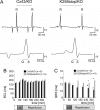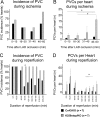Cx43 CT domain influences infarct size and susceptibility to ventricular tachyarrhythmias in acute myocardial infarction
- PMID: 19620131
- PMCID: PMC2777952
- DOI: 10.1093/cvr/cvp250
Cx43 CT domain influences infarct size and susceptibility to ventricular tachyarrhythmias in acute myocardial infarction
Abstract
Aims: Hearts of mice expressing K258stop in place of connexin43 (Cx43) protein were subjected to acute myocardial infarction in order to assess the importance of Cx43 regulation on infarct size and arrhythmia susceptibility. This mutation K258stop prevents chemical regulation of Cx43 channels, including by low intracellular pH.
Methods and results: Langendorff-perfused hearts of mice harbouring one Cx43 knockout (KO) allele and one K258stop or Cx43 allele (K258stop/KO; Cx43/KO as control) were subjected to 1 h of ischaemia and 4 h of reperfusion by reversibly occluding the left anterior descending (LAD) coronary artery. Inducibility of ventricular tachyarrhythmias (VTs) was tested by applying an endocardial burst-pacing protocol during LAD occlusion. Separately, time course and the extent of acidification-induced closure of gap junction channels were tested by dual-voltage clamp. Infarct volume (as per cent of area at risk) was significantly larger in K258stop/KO hearts compared with Cx43/KO controls (42.2 +/- 3 vs. 30.4 +/- 1.7%, P = 0.004, n = 8 each). During LAD occlusion, K258stop/KO hearts had a higher incidence of pacing-induced VT and a higher frequency of occurrence of spontaneous premature ventricular beats. The occurrence of ventricular arrhythmias was also significantly larger in the K258stop/KO hearts during reperfusion. In separate experiments, we demonstrated reduced sensitivity to acidification-induced uncoupling in cell pairs obtained from K258stop/KO hearts.
Conclusion: Loss of the regulatory domain of Cx43 leads to an increase in infarct size and increased susceptibility to arrhythmias following acute coronary occlusion.
Figures






Comment in
-
The tail of Cx43: its crucial protective role in acute myocardial infarction.Cardiovasc Res. 2009 Dec 1;84(3):337-8. doi: 10.1093/cvr/cvp329. Epub 2009 Oct 7. Cardiovasc Res. 2009. PMID: 19812045 No abstract available.
Similar articles
-
The tail of Cx43: its crucial protective role in acute myocardial infarction.Cardiovasc Res. 2009 Dec 1;84(3):337-8. doi: 10.1093/cvr/cvp329. Epub 2009 Oct 7. Cardiovasc Res. 2009. PMID: 19812045 No abstract available.
-
Connexin43 as a determinant of myocardial infarct size following coronary occlusion in mice.J Am Coll Cardiol. 2003 Feb 19;41(4):681-6. doi: 10.1016/s0735-1097(02)02893-0. J Am Coll Cardiol. 2003. PMID: 12598083
-
C-terminal truncation of connexin43 changes number, size, and localization of cardiac gap junction plaques.Circ Res. 2007 Dec 7;101(12):1283-91. doi: 10.1161/CIRCRESAHA.107.162818. Epub 2007 Oct 11. Circ Res. 2007. PMID: 17932323
-
Connexin43 and ischemic preconditioning.Adv Cardiol. 2006;42:213-227. doi: 10.1159/000092571. Adv Cardiol. 2006. PMID: 16646593 Review.
-
New insights into myocardial arrhythmogenesis: distribution of gap-junctional coupling in normal, ischaemic and hypertrophied human hearts.Clin Sci (Lond). 1996 Jun;90(6):447-52. doi: 10.1042/cs0900447. Clin Sci (Lond). 1996. PMID: 8697713 Review.
Cited by
-
Contribution of intracellular calcium and pH in ischemic uncoupling of cardiac gap junction channels formed of connexins 43, 40, and 45: a critical function of C-terminal domain.PLoS One. 2013;8(3):e60506. doi: 10.1371/journal.pone.0060506. Epub 2013 Mar 25. PLoS One. 2013. PMID: 23536911 Free PMC article.
-
Gap junctions and Bystander Effects: Good Samaritans and executioners.Wiley Interdiscip Rev Membr Transp Signal. 2013 Jan;2(1):1-15. doi: 10.1002/wmts.72. Epub 2012 Dec 11. Wiley Interdiscip Rev Membr Transp Signal. 2013. PMID: 23565352 Free PMC article.
-
Inhibition of Gap Junction Formation Prior to Implantation of Bone Marrow-Derived Mesenchymal Cells Improves Function in the Ischemic Myocardium.Int J Mol Sci. 2023 Jun 2;24(11):9653. doi: 10.3390/ijms24119653. Int J Mol Sci. 2023. PMID: 37298612 Free PMC article.
-
Simulated microgravity hampers Notch signaling in the fight against myocardial ischemia‑reperfusion injury.Mol Med Rep. 2018 Apr;17(4):5150-5158. doi: 10.3892/mmr.2018.8489. Epub 2018 Jan 25. Mol Med Rep. 2018. PMID: 29393447 Free PMC article.
-
Gap junctions.Compr Physiol. 2012 Jul;2(3):1981-2035. doi: 10.1002/cphy.c110051. Compr Physiol. 2012. PMID: 23723031 Free PMC article. Review.
References
-
- Beardslee MA, Lerner DL, Tadros PN, Laing JG, Beyer EC, Yamada KA, et al. Dephosphorylation and intracellular redistribution of ventricular connexin43 during electrical uncoupling induced by ischemia. Circ Res. 2000;87:656–662. - PubMed
-
- Kanno S, Kovacs A, Yamada KA, Saffitz JE. Connexin43 as a determinant of myocardial infarct size following coronary occlusion in mice. J Am Coll Cardiol. 2003;41:681–686. - PubMed
-
- Cascio WE, Yang H, Muller-Borer BJ, Johnson TA. Ischemia-induced arrhythmia: the role of connexins, gap junctions, and attendant changes in impulse propagation. J Electrocardiol. 2005;38:55–59. - PubMed
-
- Ruiz-Meana M, Garcia-Dorado D, Lane S, Pina P, Inserte J, Mirabet M, et al. Persistence of gap junction communication during myocardial ischemia. Am J Physiol Heart Circ Physiol. 2001;280:H2563–H2571. - PubMed
-
- Rodriguez-Sinovas A, Garcia-Dorado D, Ruiz-Meana M, Soler-Soler J. Protective effect of gap junction uncouplers given during hypoxia against reoxygenation injury in isolated rat hearts. Am J Physiol Heart Circ Physiol. 2006;290:H648–H656. - PubMed
Publication types
MeSH terms
Substances
Grants and funding
LinkOut - more resources
Full Text Sources
Medical
Molecular Biology Databases
Research Materials
Miscellaneous

